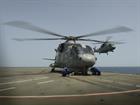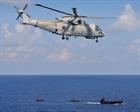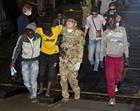Culdrose ‘Flying Tigers’ Help to Save Thousands in the Med
Aviators from RNAS Culdrose searched an area more than four times the size of Britain to help save 4,747 people in the Mediterranean.
For 60 days from first to last light, Merlin helicopters of 814 Naval Air Squadron headed out fromSicilyor from the flight deck of HMS Bulwark to look for people in distress aboard unsafe boats off the coast ofLibya.
The bulk of the squadron has now completed its migrant rescue mission over waters between Europe andNorth Africa– on the day assault ship HMS Bulwark, which picked up those people, returned home to Devonport.
With the international mission in the Mediterranean switching focus to stopping the smuggling/people trafficking, two of the three Merlin Mk2 helicopters have returned to RNAS Culdrose inCornwall, to prepare for Cougar, the Royal Navy’s annual key amphibious exercise.
Along with the amphibious assault ship, they were dispatched to the central Mediterranean at the beginning of May – the helicopters to find the vessels in distress, Bulwark and her landing craft to effect the rescue and care for the survivors.
The three helicopters clocked up 310 hours – just short of 13 days – carrying out 140 patrols on Operation Weald, codename for the UK’s mission to rescue migrants in distress in the Med. Some 4,747 people were saved from craft the Merlins located.
“It’s extremely rewarding and humbling to think that all our efforts have been converted into saving lives at sea,” said 814’s Commanding Officer Commander Stu Finn. “There’s been a real sense of purpose and value to what we have done. It’s been a real mission with real, tangible results.”
The helicopters’ four-strong crew – two pilots, one observer and one aircrewman – scoured 400,000 square miles of theMediterranean, a demanding task made easier by the Merlins’ state-of-the-art radar.
“It’s designed to spot a submarine’s periscope appearing for a matter of seconds, so locating a migrants’ boat, however small, wasn’t too difficult,” Cdr Finn explained.
“We could separate them from ordinary merchant traffic because they were small and heading north fromAfricavery slowly – we’d fly in to inspect them visually, then inform Bulwark to co-ordinate the physical rescue.”
No-one was directly rescued by the Merlins themselves – there were at least 100 migrants in each vessel encountered and the helicopters could carry no more than a dozen survivors.
They were called on to fly one pregnant survivor from Bulwark to hospital inMaltawhen her waters broke (she gave birth to a son a few hours later).
The helicopters used the Italian air base at Sigonella, just outsideCataniainSicily, as their main base, but spent most of their time either in the air or on the flight deck of HMS Bulwark, where teams of engineers carried out daily maintenance to allow the mission to continue.
Temperatures on the ground inSicilywere between 35 and 40°C which meant engineers – who, like the rest of the squadron had only just returned from operations in theMiddle Eastwhen they were sent to the Med – were working in extremely challenging conditions, while it was only slightly cooler at sea aboard Bulwark.
For the fliers, sorties over theMediterraneanwere long – but something they were used to.
“We’re naval aviators. We love operating aircraft at sea. It’s what we joined up for,” says Cdr Finn. “To the unfamiliar eye, it may have looked quite daunting and monotonous staring at these expanses of blue, but for the observer and aircrewman staring at the radar picture it was very different.
“Thanks to the radar and information provided by other ships, we could identify the smallest migrant boats relatively quickly. On the busiest sortie, we encountered five vessels in a little over 30 minutes.”
One Merlin Mk2 remains in theMediterranean, with around two dozen air and ground crew flying/looking after it, conducting sorties working with HMS Enterprise and the ships of EUNAVFOR on the ongoing mission.
The public will be able to see Merlin helicopters close up and speak to personnel who have just returned from Operations at RNAS Culdrose’s annual Air Day on Thursday 30th July.







